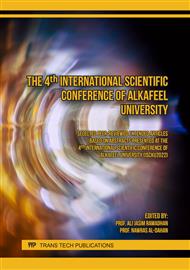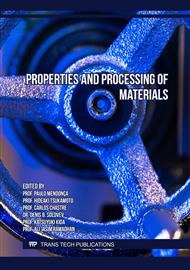[1]
P. Bagas, K. Thiya, B. D. N. Asep, Economic Perspective in the Production of Magnetite (Fe3O4) Nanoparticles by Co-Precipitation Method, Chem. Eng. World. Vol. 2, No. 2, (2018): PP.1– 4.
Google Scholar
[2]
M. H. N. Assadi, J. J. G. Moreno, D. A. Hanaor, H. K. Yoshida, Exceptionally high saturation magnetisation in Eu-doped magnetite stabilised by spin–orbit interaction, Phys. Chem. Chem. Phys. Vol.23, No.36, (2021), PP. 20129-20137.
DOI: 10.1039/d1cp02164h
Google Scholar
[3]
M. A. Subhan, P. C. Saha, J. Ahmed, A. M. Asiri, M. Al-Mamun, M. M. Rahman, Development of an ultra-sensitive paranitrophenol sensor using tri-metallic oxide MoO2· Fe3O4· CuO nanocomposites, Adv. Mater. Vol. 1, No.8, (2020), PP. 2831-2839.
DOI: 10.1039/d0ma00629g
Google Scholar
[4]
A. B. Taha, M. Sh. Essa, B. T. Chiad, Spectroscopic Study of Iron Oxide Nanoparticles Synthesized Via Hydrothermal Method, Chem. Methodol. Vol. 6, No. 12, (2022), PP.977-984
Google Scholar
[5]
S. Saqib, M.F.H. Munis, W. Zaman, F. Ullah, S.N. Shah, A. Ayaz, S. Bahadur, Synthesis, characterization and use of iron oxide nanoparticles for antibacterial activity, Microsc. Res. Tech., Vol. 82, No. 4, (2019), PP.415-420.
DOI: 10.1002/jemt.23182
Google Scholar
[6]
R.B. Ayed, M. Ajili, N.K. Turki. Physical properties and Rietveld analysis of Fe2O3 thin films prepared by spray pyrolysis: effect of precursor concentration, Phys. B: Condens. Matter, Vol.563, (2019), PP. 30-35.
DOI: 10.1016/j.physb.2019.03.029
Google Scholar
[7]
A. Benhammada, D. Trache, M. Kesraoui, A.F. Tarchoun, S. Chelouche, A. Mezroua, Synthesis and characterization of α-Fe2O3 nanoparticles from different precursors and their catalytic effect on the thermal decomposition of nitrocellulose. Thermochim. Acta, Vol. 686, (2019), P.178570.
DOI: 10.1016/j.tca.2020.178570
Google Scholar
[8]
A.M. Nahrawy, A.B.A. Hammad, T.I. Shaheen, A.M. Mansour, Sol-gel synthesis and physical characterization of high impact polystyrene nanocomposites based on Fe2O3 doped with ZnO, Appl. Phys. A. Vol.126, No. 8, (2020), PP. 1-11.
DOI: 10.1007/s00339-020-03822-w
Google Scholar
[9]
A.E. Yachmenev, S.S. Pushkarev, R.R. Reznik, R.A. Khabibullin, D.S. Ponomarev, Arsenides and related III-V materials-based multilayered structures for terahertz applications: Various designs and growth technology, Prog. Cryst. Growth Charact. Mater. Vol. 66, No. 2, (2020), P. 100485.
DOI: 10.1016/j.pcrysgrow.2020.100485
Google Scholar
[10]
O. Karaagac, H. Köçkar, the effects of temperature and reaction time on the formation of manganese ferrite nanoparticles synthesized by hydrothermal method, J. Mater. Sci. Mater. Vol. 31, No. 3, (2020), PP.2567-2574.
DOI: 10.1007/s10854-019-02795-8
Google Scholar
[11]
A. G. Nonaka, M. A. Batista, A. C. S. D. Costa, T. T. Inoue, T. G. M. Bonadio, I. G. D Souza, Kinetics of Thermal Transformation of Synthetic Al-Maghemites into Al-Hematites, Revi. Brasi. de Ciên. do Solo. Vol. 41, (2017), PP. 1-13.
DOI: 10.1590/18069657rbcs20160384
Google Scholar
[12]
F. Ozel, H. Kockar, O. Karaagac, Growth of iron oxide nanoparticles by hydrothermal process: effect of reaction parameters on the nanoparticle size, J. Super cond. Nove Magn.Vol.28 (2015), PP. 823-829
DOI: 10.1007/s10948-014-2707-9
Google Scholar
[13]
M. Rabiei, A. Palevicius, A. Monshi, S. Nasiri, A. Vilkauskas, G. Janusas, comparing methods for calculating nano crystal size of natural hydroxyapatite using X-ray diffraction, J. Nanomater. Vol. 10, No. 9, (2020), P. 1627.
DOI: 10.3390/nano10091627
Google Scholar
[14]
Y. Zhang, S. Guo, P. Zhang, J Zhong, W. Liu, Iron oxide magnetic nanoparticles based low-field MR thermometry, Nanotechnology. Vol.31, No.34, (2020), P. 345101.
DOI: 10.1088/1361-6528/ab932b
Google Scholar
[15]
J. Zhang, F. Huang, Z. Lin, Progress of nanocrystalline growth kinetics based on oriented attachment, Nanoscale. Vol. 2, No. 1, (2010), PP. 18-34.
DOI: 10.1039/b9nr00047j
Google Scholar
[16]
B. Udvardi, I. J. Kovács, T. Fancsik, P. Kónya, M. Bátori, F. Stercel, Z. Szalai, Effects of particle size on the attenuated total reflection spectrum of minerals, J. Appl. Spectrosc.Vol. 71, No. 6, (2017), PP.1157-1168.
DOI: 10.1177/0003702816670914
Google Scholar
[17]
A. S. Jawad, A.F. Al-Alawy, Synthesis and characterization of coated magnetic nanoparticles and its application as coagulant for removal of oil droplets from oilfield produced water, AIP Conf. Proc. Vol. 2213, No. 1, (2020) P. 020174.
DOI: 10.1063/5.0000279
Google Scholar
[18]
E. M. El Afifi , M.F. Attallah, E.H. Borai , J., Utilization of natural hematite as reactive barrier for immobilization of radionuclides from radioactive liquid waste, J. Environ. Radioact., Vol. 1(2016), PP. 156-165.
DOI: 10.1016/j.jenvrad.2015.10.001
Google Scholar
[19]
J. Lewandowska-Łańcucka, M. Staszewska, M. Szuwarzyński, M. Kępczyński, M. Romek, W. Tokarz, M. Nowakowska, Synthesis and characterization of the superparamagnetic iron oxide nanoparticles modified with cationic chitosan and coated with silica shell. J allo. comp., Vol. 586 (2014), PP. 45- 51.
DOI: 10.1016/j.jallcom.2013.10.039
Google Scholar
[20]
D. Mishra, R. Arora, S. Lahiri, S.S. Amritphale, N. Chandra, Synthesis and characterization of iron oxide nanoparticles by solvothermal method. Prote. Meta.Phys. Chem. Surf., Vol. 50 (2014), PP. 628–631.
DOI: 10.1134/s2070205114050128
Google Scholar



